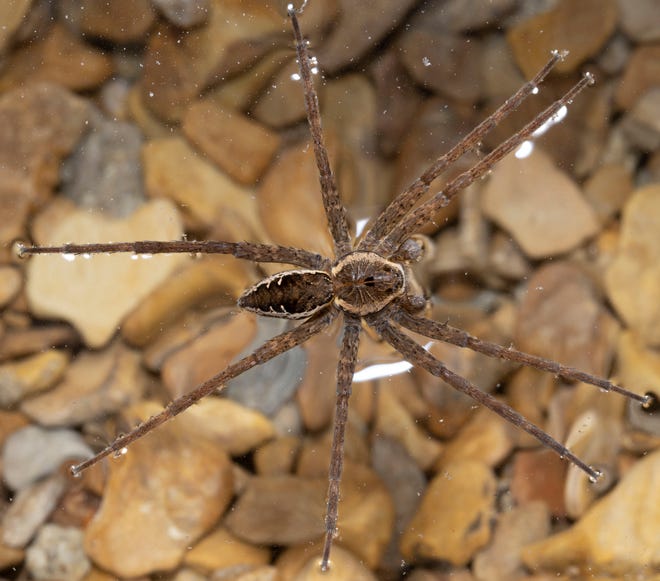Nature: An 8-legged fishing find that's a sight to see

Well, I’ll probably lose the love of the arachnophobes with this column. As arachnophobia afflicts about 6% of the population, my readership might shrink by a few people. But if you’ve read this far and spiders spook you, please return for a future column. It’ll likely be about chickadees, spring-beauties, cottontails or some such warm-and-fuzzy subject.
Back on Feb. 24, an unseasonably balmy day with temps in the low 50s, fellow nature lovers Shauna Weyrauch, John Howard, Mary Johnson and I met up in Scioto County to search for amphibians. Our search area was in and around a small lake deep in the 70,000-acre Shawnee State Forest in Scioto County.
Nature:Once-abundant rusty blackbird threatened by habitat destruction
We had much success by turning rocks and logs, and grubbing in a spring-fed mire. A highlight was a northern red salamander. The shallow lake waters harbored scores of red-spotted newts. This salamander is strictly aquatic as an adult, and swims well.
While wrangling some newts for photographs, I noticed a large spider lurking near the bank. One of the fishing spiders! Our attention thus diverted, we wasted no time in capturing the eight-legged beast and temporarily detaining it for a modeling session. The fruits of my photographic labors accompany this column, and I’m sure you’ll agree that this is one handsome spider.
Ohio hosts about a half-dozen species of fishing spiders, and later research showed this one to be the banded fishing spider (Dolomedes vittatus). As spiders go, this is a big ‘un.
The protagonist of this story was on the small side — perhaps one that was born last summer — but would still span most of your palm if at rest on your hand. She’ll get bigger yet. Fully grown adult females have a leg span of four inches. Females overwinter and can be active on warmer days. The smaller males are normally found only in the warmer months.
The unusual name “fishing spider” for this group stems from their ability to skate across the water’s surface, and even dive into the depths. Small fish, tadpoles and aquatic insects are all fair game.
I once watched a massive six-spotted fishing spider hunting from lily pads. When a low-flying dragonfly would pass near, the spider would make a sudden lunge skyward, attempting to grab the insect. I didn’t get to see any kills, but I’m sure it succeeded on occasion.
Nature:Native plant update: Of Ohio's 1,800 native plants species, 271 are endangered, 93 are gone
Another name for this group of arachnids is nursery web spiders. Females lay a large egg mass, and carry this case under the body, holding it with the jaws. When hatching is imminent, the female creates a silken “nursery” by webbing leaves together to build a protected space. The doting mother then guards the scores of spiderlings until they are ready to disperse.
I once picked up the eye shine of a large spider in a flashlight beam while doing some nocturnal exploration. It was about eight feet up in a redbud tree, and I moved in for a closer look. A convenient log allowed me to jump up and get on its level, and I was pleased to see a particularly elegant, gigantic white-banded fishing spider guarding a nursery.
She, apparently displeased with the interloper, quickly darted in my direction. While not particularly intimidated of spiders, I must admit to quickly hopping down and giving the family its space (but returning later for macro photos).
Nature:Venomous madtom catfish a lesser known species in Ohio that packs a punch
Ohio plays host to about 650 spider species. Most of them are tiny, and out of sight and mind. Not so much the big spectacular fishing spiders, although even these giants are adept at hiding and most people miss them. Save perhaps females guarding nurseries, fishing spiders are seemingly quite mellow when encountered and a person would probably have to work to get bitten.
Naturalist Jim McCormac writes a column for The Dispatch on the first and third Sundays of the month. He also writes about nature at jim mccormac.blogspot.com.